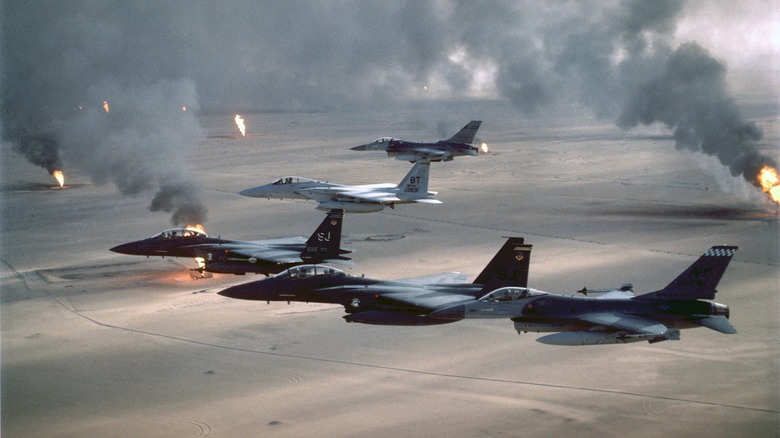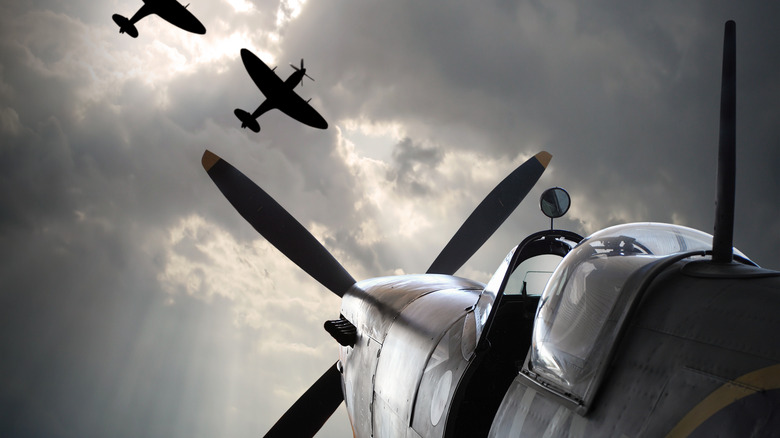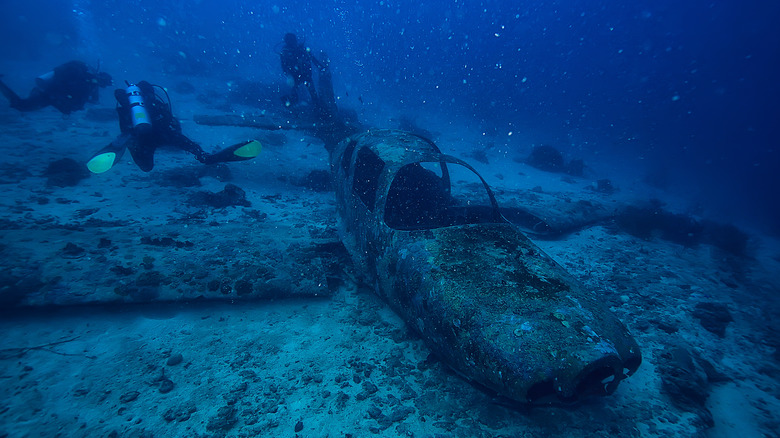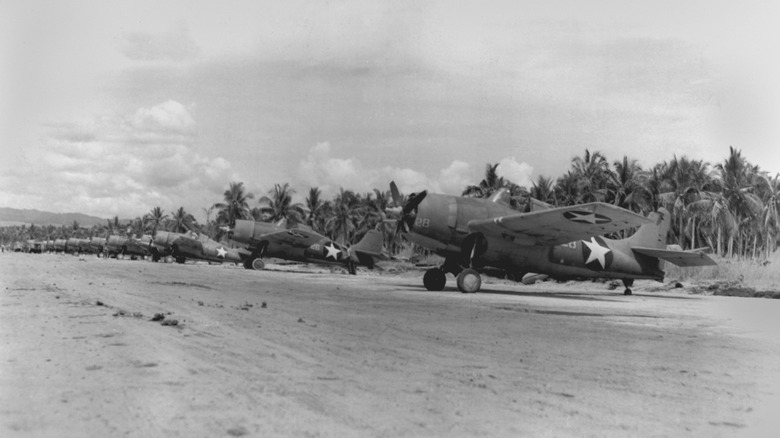The 7 Of The Most Important Air Battles In Military History
Crewed aircraft have played a crucial role in combat since the fledgling days of aviation. It was just over 10 years since the Wright Brothers made history with Kitty Hawk's maiden flight when aircraft were first deployed to do battle over Northern France in World War I. While the evolution of flight was swift, aerial warfare can trace its roots back as far as the kites that carried warriors in ancient China, and lighter-than-air balloons have since been used for reconnaissance purposes. However, the 20th-century development of the internal combustion engine and modern weaponry heralded a new era of combat, the like of which had never been seen before.
Modern aerial warfare has changed considerably since the dog-fighting aces of World War I, with strategic bombing, airstrikes, and drone warfare playing more dominant roles over air-to-air combat. However, air battles have historically played pivotal roles in many conflicts, including the Korean War, Vietnam, the Gulf War, and, more recently, in the skies over South Asia and the Middle East. It could be argued that aerial combat was never more essential to victory than during World War II, when it was instrumental in starting and ending the war in the Pacific Theater and defending the skies over Europe.
Air battles continue to influence the outcome of major conflicts, but some are remembered as decisive moments in history. These clashes played a significant role in the outcome of their respective wars, many of which caused considerable loss of life and destruction in achieving their objective. The following seven battles not only demonstrated the importance of air power but also had far-reaching strategic and geopolitical consequences. They serve as key milestones in military history and have shaped how modern air forces are organized and employed.
Battle of Britain
Few battles played such a pivotal role in the outcome of World War II as the Battle of Britain. While much has been made of Allied dominance after the D-Day landings and victory on the Eastern Front, there were years when the future of Europe hung in the balance. Great Britain suffered a major setback in the summer of 1940 after having to withdraw from northern France in the infamous Dunkirk evacuation; morale was low, and a German invasion of the island nation was looking increasingly likely after France accepted defeat. Hitler put his plan into action later that year, choosing to first invade from the sky, as the Germans were unprepared for a land invasion.
In July 1940, Air Marshall Hermann Goring took the responsibility to break Britain's resolve using his fearsome Luftwaffe to disrupt the Royal Air Force and Royal Navy, starting with a strategic bombing campaign of factories, ports, and communication centers. Britain responded with its Fighter Command split into four divisions, using Hawker Hurricane and Supermarine Spitfire fighter planes. These were pitted against the German Junkers 88 and Heinkel He 111 light bombers, which were supported by Messerschmitt Me 109 fighters. The Battle of Britain was underway.
Luckily for the Allies, the British fighters proved to be superior machines to their German counterparts. However, resources were dwindling, and the Allies were perilously close to defeat as they regained air supremacy and drove the Nazi threat from its shores. The RAF's successful resistance prevented a German invasion and marked a turning point in the war. Hitler responded with Blitzkrieg, or "lightning war," over London and strategic British cities, as Allied bombs decimated Berlin, and air-to-air combat gave way to psychological warfare that directly targeted civilians.
Pearl Harbor
The attack on Pearl Harbor has gone down in history as the infamous surprise attack that drew the United States into World War II in the Pacific, followed shortly after by the European theater of war. While the specific nature of the attack undoubtedly caught the United States unawares, it had been anticipating hostilities from Japan for some time.
U.S. intelligence had intercepted codes planning to halt diplomatic negotiations after Japan's occupation of Indo-China (Vietnam) forced Franklin D. Roosevelt to impose sanctions on oil exports. As tensions grew between the two nations, it soon became apparent that a significant conflict was inevitable. However, the U.S. was quite unprepared for an attack on its naval base in Pearl Harbor, Hawaii, 3,000 miles from the epicenter of the situation.
At 7:48 a.m. local time, the Imperial Japanese Navy attacked Pearl Harbor using various aircraft and seaborne vessels. These included level bombers, dive bombers, torpedo planes, submarines, various large support vessels, and the now-notorious Mitsubishi Zero fighters, transported via four heavy aircraft carriers. In around 90 minutes, the base was decimated, giving the United States forces no time to react. Nineteen warships and 300 aircraft were destroyed in the attack, and over 2,500 people lost their lives.
The attack on Pearl Harbor demonstrated the devastating potential of carrier-based aircraft. It served as a harbinger of the conflict to come in the Pacific Theater of World War II. The very next day, the United States declared war on Japan, with Roosevelt's speech referring to the Pearl Harbor attack as a "day of infamy." Just three days later, on December 11th, it had also declared war on Germany, and the United States was brought into the war on all fronts.
St. Mihiel Salient
The St. Mihiel Salient was a large wedge-shaped piece of German-occupied land between the towns of Verdun and St. Mihiel on the Western Front in World War I. It had proved difficult for French forces to reclaim, and it was essential to overcome this strategic obstacle if the Allies were to push through and overcome the German lines of defense. The responsibility came to lie at the feet of the Americans and Colonel Billy Mitchell, who set about assembling the largest air force ever seen to tackle the problem from above.
The following conflict was to be one of the first large-scale aerial battles ever fought and remains one of the largest of all time. It was a massive undertaking involving 1,476 American and French aircraft, pitted against 500 German planes. Ground support was provided by tanks under the legendary George S. Patton, who returned to command the 2nd Armored Division in World War II.
The air battle over the St. Mihiel Salient was one of the first instances in which American air power played a substantial role in a major offensive during World War I, flying 390 sorties and dropping 14,300 pounds of bombs on the salient on the first day alone. By the time the battle was over, 2,469 sorties had been flown, around 44-thousand pounds of bombs had been dropped, and 145 aerial combats had been recorded. Despite this activity, only 40 Allied lives were lost, with 16 taken prisoner by the time the Allies claimed victory.
Battle of Midway
The Battle of Midway is considered one of history's most decisive naval battles. The Imperial Japanese Navy's main objective was to decimate the United States maritime fleet, unseating its position in the Pacific Theater, to allow Japan to gain a solid foothold to attack Pearl Harbor and dominate the region. It was fought over Midway Atoll, an aptly-named group of islands placed almost dead-center in the Pacific Ocean.
The battle was waged on June 4, 1942, just a few months after the attack on Pearl Harbor. This time, thanks to intercepted intelligence, the United States had the upper hand, with the knowledge that an attack was imminent in a coded location called "AF." When the U.S. sent a dummy message about a lack of fresh water on Midway, Japan relayed this information along with the codename; hence, the Allies became aware that this was where the attack would occur.
As expected, the Japanese attacked the Midway base early in the morning, while unbeknown to them, U.S. carriers waited offshore, prepared for a full-scale assault. Once the Japanese returned after refueling, the Americans let them have the full force of their might, sending wave after wave of torpedo bombers and dive bombers to decimate four of Japan's major aircraft carriers.
Over two days of attacks, American carrier-based aircraft defeated the Imperial Japanese Fleet, crippling its offensive capabilities in the Pacific and shifting the balance of power in favor of the Allies. The tables had finally turned as the United States gradually tightened its grip, fighting from island to island in the brutal Pacific campaign.
Operation Desert Storm
The Gulf War was already in full swing in mid-January 1991 when the campaign codenamed Operation Desert Storm commenced. In August 1990, after Saddam Hussein invaded neighboring Kuwait, 42 countries led by the United States entered into a coalition called Operation Desert Shield. The allies initially built up a strong presence in Saudi Arabia to protect its borders from Iraq before it came time to end the conflict, and a combined air and ground offensive was the agreed solution.
Desert Shield's successor, Operation Desert Storm, started with a coordinated air offensive that rocked the foundations of Saddam's defenses. Nine Apache helicopters descended on Baghdad, launching 27 Hellfire missiles to knock out its main communications centers, followed closely by 100 Hydra-70 rockets to destroy its anti-aircraft guns. This gave a wave of U.S. and coalition fighter jets free reign to move in and decimate Iraq's supply lines and defenses, as a battery of cruise missiles was deployed and B52 bombers struck the capital.
This brutal offensive gravely impacted Baghdad's civilians, who were then targeted with a flier-dropping campaign designed to sway the masses to the allies' favor. In this regard, it was a battle fought on two fronts, both military and personal.
This air campaign during the Gulf War showcased the effectiveness of modern precision-guided munitions and coalition air forces. The rapid destruction of Saddam Hussein's military infrastructure paved the way for a ground offensive to liberate Kuwait in a matter of days. It has since been referred to as the "first space war" due to its being the first conflict to make extensive use of GPS technology, satellite communications, and better situational awareness with advanced tracking of friendly forces.
Battle of Guadalcanal
The Japanese Imperial Navy had been crippled following the Battle of Midway. It had created a defensive bank of occupied islands throughout the western Pacific, and the Allied forces started to pick them off one at a time as it closed in on its primary objective of the Japanese mainland. The first of these was Guadalcanal in the Solomon Islands, which marked the beginning of the Allied offensive in the South Pacific on August 7th, 1942.
Known as Operation Watchtower by U.S. forces, the Guadalcanal campaign was a series of air and naval battles around the Solomon Islands, which highlighted the significance of air control in amphibious operations. After landing on the island, the Allies were met with a series of logistical issues compounded by the intense heat, humidity, and dense jungle conditions. Resupply was difficult, and the ground troops were under continual aerial bombardment from Japanese aircraft.
The Japanese planes were intercepted by Allied air power, which was named the "Cactus Air Force," operating out of Guadalcanal's Henderson Field. Many intense air battles were fought over the six-month duration of the campaign, with a total of 615 Allied and 638 Japanese aircraft destroyed. The human loss of life was significant. About 7,100 Allied troops lost their lives, and 31,000 Japanese troops fell by the time the Imperial Navy withdrew from the Solomon Islands, giving the Allied forces their first taste of the remarkable tenacity of the Japanese soldiers when met face to face.
Battle of Kursk
After the Soviet forces claimed victory at Stalingrad, they started a major offensive in Russia's south. In July 1943, the city of Kursk in Western Russia was the site of a sizeable Russian-occupied salient that infiltrated 100 miles into the German lines. It proved to be a crucial obstacle that would determine German success on the Eastern Front, and a surprise attack was planned from the north and south to reclaim Germany's foothold in Russia.
The German forces consisted of around 900,000 troops and included 2,700 tanks and artillery, but they were outfoxed by the Soviets, who anticipated the assault and withdrew their troops before decimating them with mines and antitank missiles. It was then the Soviet's turn for a counteroffensive. Both German and Soviet forces were aware that ground forces would not triumph without considerable air support, and Stalin vowed to gain air superiority.
Russian Ilyushin Il-2 Sturmovik "Flying Tank" dive bombers were pitted against a fearsome mixture of Stuka dive bombers, Junkers Ju 88 and Heinkel He 111 medium bombers, as well as Germany's faithful Messerschmitt Bf 109 fighter planes. In total, 4,000 aircraft took to the skies in one of the largest-scale aerial combats of World War II.
After suffering heavy losses, the Soviet forces changed tactics and overpowered the Germans in the air. Largely thanks to intense air support, troops on the ground started advancing to repel the Germans. Ultimately, the Soviets' ability to contest the skies over Kursk played a crucial role in their victory and marked a turning point on the Eastern Front as they began advancing on Berlin.







